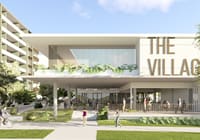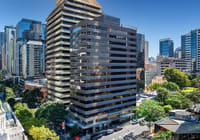
In thriving New York, SoHo's soaring rents keep storefronts empty
Charles V. Bagli
At the height of the recession, as most of the country struggled, SoHo thrived. Between 2010 and 2014, rents for stores in the former industrial district in lower Manhattan soared by 75 per cent, to an annual $US860 ($1088) a square foot, or $US4.3 million a year for a 5000-square-foot (464-square-metre) storefront, as national chains pushed into the neighbourhood, willing to pay seemingly any price to get a piece of the action.
Those were the good old days.
Now, with the city’s unemployment at near historic lows and the economy humming along, empty storefronts dot SoHo’s streets, with 16 in the six-block stretch of Broadway between Houston and Canal streets, the area’s retail spine. More stud the Belgian-blocked side streets, dark gaps between boutiques selling high fashion and designer furniture and the occasional remaining art gallery.
“We’re seeing no velocity in leasing,” said C. Bradley Mendelson, vice chairman of Colliers, a real estate firm, and a longtime retail broker. “No one’s taking space.”
Maybe not “no one”: T.J. Maxx, the discount department store chain more often found in suburban malls, has signed a deal for a large storefront on Broadway, according to real estate executives active in SoHo who spoke anonymously because they were not authorised to discuss the deal and did not want to jeopardise their relationship with the building’s owner. And a new restaurant is finally scheduled to open in what had been the longtime home of a popular dive bar called Milady’s, at Prince and Thompson streets. The bar served its last drink three years ago, and the spot has been vacant ever since.
Across the country, retailers have been wounded by competition from Amazon and other internet sales sites, prompting caution in opening new stores, be it in the suburbs, in SoHo or on Fifth Avenue. But the problems in New York City, and in particular SoHo, go beyond that, brokers and retail experts say.
“Right now, it feels like retail is on pause,” said David LaPierre, a retail specialist and a vice chairman at CBRE, a real estate services company. “Rents need to get to a much more realistic level.”
SoHo was once home to small factories, wholesalers and workshops. In the 1960s, artists in search of low rents and big spaces moved into the lofts, often illegally. Over time, art galleries, small boutiques and furniture designers followed, giving the neighbourhood cultural cachet. Starting in the 1990s, though, more stores moved in, the galleries decamped for Chelsea and other neighbourhoods, and the streets filled with tourists from around the world, often laden with shopping bags.
But rents escalated far faster than retail sales throughout Manhattan. Between 2010 and 2014, retail sales in Manhattan climbed 31.9 per cent, while rents soared by 90 per cent, according to CBRE.
In SoHo, big commercial real estate firms like Thor Equities, 60 Guilders and Premier Equities bought out longtime small-scale landlords, pushing rents there even higher.
The area also became a hub of flagship stores, for which chains pay top dollar to expand their brand identity and don’t mind breaking even, or even losing money. Typical is the five-story, 5110-square-metre Nike behemoth at Broadway and Spring Street that opened last winter.
“Everything became a flagship,” said Mendelson, of Colliers. “But you can’t have one on Fifth, one in Times Square and one in SoHo. Flagships don’t make money. They’re ad vehicles to promote the retailer.”
Only the biggest brands can afford that kind of promotion. “At those levels, many retailers simply can’t afford their store,” said LaPierre, of CBRE. “I don’t know any retailer who can survive while paying 50 per cent of their revenue in rent.”
After rents peaked in 2014, vacancies began opening up and rents slipped. By the spring of 2017, the average asking rent for shop space on Broadway had fallen 21 per cent, to $678 a square foot per year, according to CBRE.
And still, there are plenty of locations to choose from.
Some landlords have started finding ways to generate income. Pop-up stores – which take over a space temporarily, with a predetermined end date – offer landlords what Beth Rosen, a retail broker at RKF, a national firm, calls a “kind of a band-aid for the space,” bringing in revenue but not foreclosing the possibility of a permanent rental paying the higher asking rate. Rosen said that SoHo landlords are more willing than ever to permit the short-term stores, “if they can’t get the rents they want, and it’s a way for the tenant to get comfortable.”
After a successful run as a pop-up store on Spring Street, Aerie, a lingerie and clothing chain developed by American Eagle, is looking for a more permanent spot in SoHo. Untuckit, a store featuring high-end shirts designed to be worn loose, also wants a long-term lease after testing the market on Prince Street.
Some landlords are offering short-term leases while they hunt for higher-paying long-term tenants, giving store owners months free for a limited period, or offering money or a discount on the rent to be used toward building a store.
Cases like Milady’s, where an older business closes and then the storefront sits fallow for months or even years, can seem puzzling.
But building owners who purchased their properties in recent years with the expectation that rents could only continue to rise may be in a bind. To secure financing, they would have to project a certain level of income, and if they accept less than that, they run the risk of being in default, or having their lender require them to put more equity into the building. At some point, LaPierre said, those owners will lose their buildings or have to find a partner willing to invest money in the property.
“We’d been asking ourselves, when is this bubble going to burst?” said Sean Sweeney, a SoHo resident since the 1980s and a leader of the SoHo Alliance, a group of residents and longtime shop owners who want to preserve their vision of SoHo, with its narrow streets, low-scale buildings, artists’ lofts and independent retailers.













